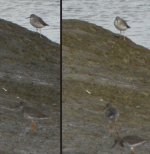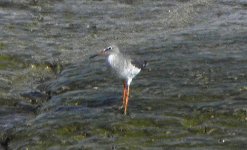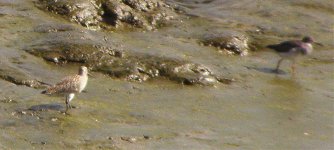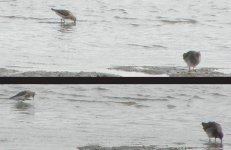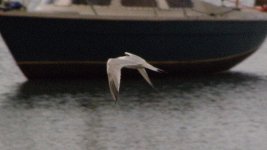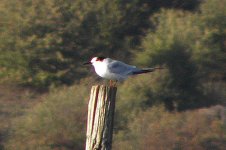Alexjh1
Well-known member
Assorted Waders, Oare Marshes, Kent *UPDATE* Now with Terns
I was down at Oare Marshes on Monday and amounst the tons of stuff that was around and readily identifiable (Redshank, Golden Plover, Dunlin, Avocet, Blackwit, Curlew Sand, Turnstone, Ringed Plover, Ruff, Lapwing, Curlew, Knot) I spotted a few birds which I wasn't quite so sure on. I do have photos, but unfortunatly none of them are that great quality, but I'd really appreciate any identifications people would be able to help me with!
Where applicable, I've left the redshanks in the pictures to help judge scale.
1) (Bird at the Back) - I presume this is a redshank, but just checking on the basis that it doesn't have the red legs and seemed a little larger than the others.
2) Again, I presume this is a redshank, but it seemed paler/greyer, more lightly built and more leggy than the others. But it also doesn't have the right beak for a spotted redshank.
3) Looing at the brown bird in the foreground - unfortunatly this is the only photo of the bird I got, but it has a fairly long curved black beak. I'd guess whimbrel (way too small for curlew), but it seemed a bit chunkier than whimbrel I've seen before.
4) Looking at the smaller, rear bird, it's obviously one of the smaller waders, but I'm not sure which one - the beak is too short for dunlin or curlew sand - I'm going to go out on a limb here (and probably end up looking stupid doing so) but was thinking perhaps little stint (which had been around the reserve in the last few days) but as that's a species I've never seen I didn't want to jump to conclusions.
Thanks for any help!
I was down at Oare Marshes on Monday and amounst the tons of stuff that was around and readily identifiable (Redshank, Golden Plover, Dunlin, Avocet, Blackwit, Curlew Sand, Turnstone, Ringed Plover, Ruff, Lapwing, Curlew, Knot) I spotted a few birds which I wasn't quite so sure on. I do have photos, but unfortunatly none of them are that great quality, but I'd really appreciate any identifications people would be able to help me with!
Where applicable, I've left the redshanks in the pictures to help judge scale.
1) (Bird at the Back) - I presume this is a redshank, but just checking on the basis that it doesn't have the red legs and seemed a little larger than the others.
2) Again, I presume this is a redshank, but it seemed paler/greyer, more lightly built and more leggy than the others. But it also doesn't have the right beak for a spotted redshank.
3) Looing at the brown bird in the foreground - unfortunatly this is the only photo of the bird I got, but it has a fairly long curved black beak. I'd guess whimbrel (way too small for curlew), but it seemed a bit chunkier than whimbrel I've seen before.
4) Looking at the smaller, rear bird, it's obviously one of the smaller waders, but I'm not sure which one - the beak is too short for dunlin or curlew sand - I'm going to go out on a limb here (and probably end up looking stupid doing so) but was thinking perhaps little stint (which had been around the reserve in the last few days) but as that's a species I've never seen I didn't want to jump to conclusions.
Thanks for any help!
Attachments
Last edited:




